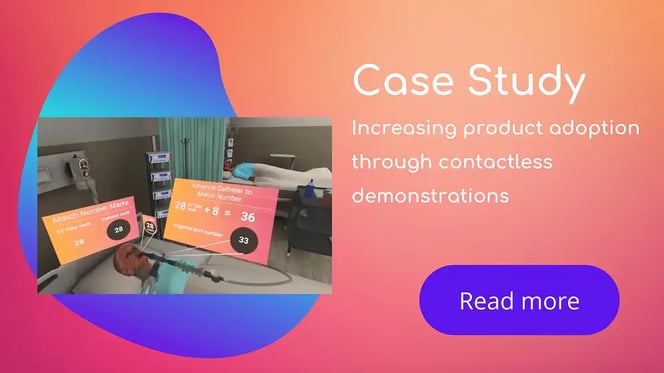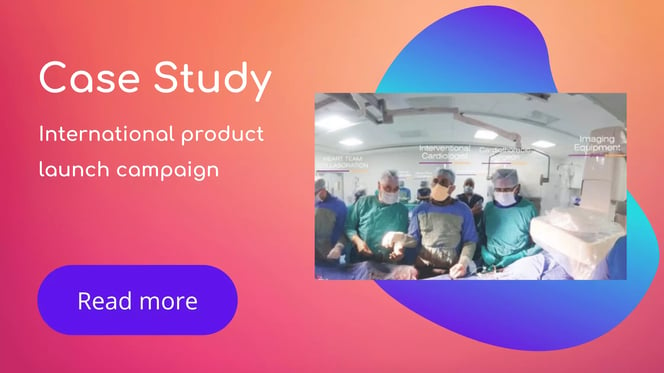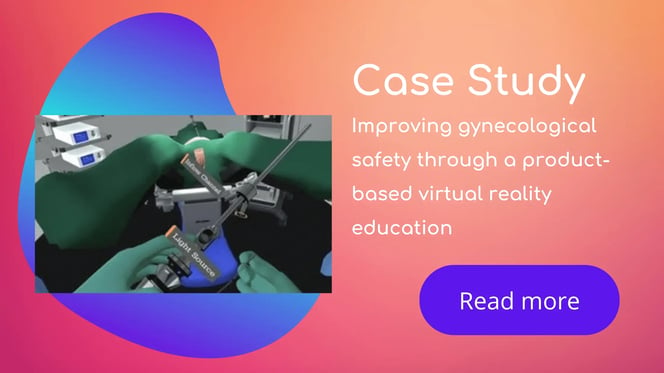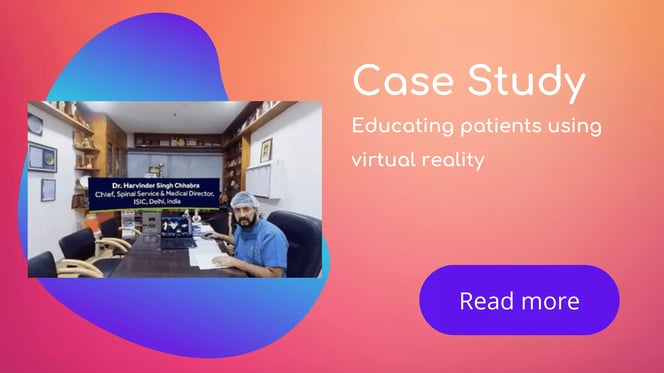How virtual reality is accelerating adoption of medical devices
If medicine is all about saving and improving lives, medical technology is about making that more effortless, more precise, and less troublesome for doctors and patients. There is one catch, though. It takes diligence and many years of hard work to master the complex human body sufficiently to follow the basic principle of medicine—primum non nocere (first, do no harm). And technology can lend that space to polish skills.
As a manufacturer of medical devices, you are acutely conscious of the medical industry needs & trends. And the competition that comes along. So, to do well commercially and to accelerate adoption of your device, you must provide an engaging experience of your device to its key stakeholders.
Here is how the intersection of medical device marketing and Virtual Reality helping marketers overcome the adoption challenge:
What does challenges in enablement mean to medical device marketing?
Enablement of different stakeholders like sales, users or HCPs, patient, and non-medical buyers, involved in medical device purchase decision & adoption is very important aspect in medical device marketing. Here are the challenges medical devices industry face in enabling these stakeholders:
a. Sales enablement :
Forbes mentions ‘sales enablement' as a hot buzzword in marketing. And explains it as "the activities, systems, processes, and information that support and promote knowledge-based sales interactions with clients and prospects."
It becomes challenging to impart precise product knowledge in sales team when there are rapid product innovations, products upgrades, and the frequent launch of new products.
b. Buyer enablement :
A whitepaper on News Medical Life Sciences emphasizes that, with technological advancements the salespeople must be able to demonstrate succinctly how and why a newly launched device is superior to existing alternatives. An efficient and engaging explanation of a medical device is best achieved with a ‘live’ demonstration, but it comes at heavy investments of time, transportation & setup of a device in a clinical environment.
c. User enablement :
Conventionally, user enablement has been done by arranging training workshops, operator’s manuals, and videos. Healthcare professionals (HCP) prefer to experience the benefits of a product directly before deciding whether to adopt it into their day-to-day practice or not. While videos can demonstrate a product’s features, they are unable to provide the opportunity to ‘learn by doing’ that would augment HCPs’ confidence in its operation and benefits. And training workshop involves high cost and logistics.
d. Patient enablement :
Ultimate beneficiary of any new technology is the patient; hence it is important to help the hospital communicate the new technology advantages to the patients. Not doing it well can lead to lower adoption of latest technologies by patients. Patients may reject new technology in favor of less expensive treatments, which may also lead to commercial loss for the hospitals.
How immersive technology like virtual reality is helping marketers overcome enablement challenges?
HubSpot suggests that 93% of all human interaction is composed of visual content. This infers that individual will likely to be influenced by seeing an experiential video demo of using your medical device. Even better are the statistics when technology like Virtual Reality is used. Here are few examples of how Virtual Reality is accelerating enablement and adoption of medical devices.
a. VR for sales enablement :
With effective sales enablement that supplies the right training, coaching and content, medical device reps can have more successful interactions with buyers and make the most of their time in the field.
Ethosh created an immersive, VR-based, simulated product procedural demonstration that enabled sales team with more precise product knowledge. An animated and interactive virtual experience helped HCPs better understand the benefits of the device, which in turn increased their confidence in adopting the device in their practices. Because the product was expensive, it had higher demonstration and sales costs, leading to a lack of quality, immersive learning opportunities for nurses and doctors.
This lowered demo and sales costs and increased HCPs’ confidence in the product at the same time. Also, better retention due to immersive and engaging learning was a notable outcome.
b. VR for buyer enablement :
News Medical Life Sciences affirms ‘Seeing is Believing.’ It further explains, ‘How qualities of customized high-fidelity VR simulators not only bring health care practitioners to your booth but encourages them to stay longer to get hands-on with the new device. This gives you a chance to gain extended and more productive engagement, as health care practitioners can build up an accurate understanding of the procedure and grow more likely to be open to trying the first case.’
Citing fine example of how VR enabled international product launch and awareness campaign by Ethosh increased impressions and interest at medical conference. And resulted in increased sales throughout Europe.
An indigenously produced cardiac valve received CE clearance, but its features and benefits needed to be highlighted for European cardiologists. Ethosh designed an out-of-the-box marketing with 360-degree immersive cathlab experience. As the cathlab experience was portable, was conducted throughout Europe with ease. It allowed the cardiologists to gain experience and confidence by performing the procedure. enabling them to understand and feel more connected to the benefits of the valve after engaging with the product.
c. VR for user enablement :
An excerpt from Harvard Business Review states," Virtual-reality-based training systems offer an intriguing solution to several aspects of challenges. By definition, VR uses computer technology to create a simulated environment, placing the user inside an experience. These platforms directly address the skills gap by providing immersive, hands-on training that closely simulates an operating room environment. VR platforms offer portable, on-demand training that can be used anytime, anywhere."
Some promising statistics to support VR-based simulated training, much-needed tool for surgeons
- 82% of health professionals agree that XR will successfully remove the significant hurdle of distance in accessing people and offering better services.
- 'ResearchAndMarkets' predicts that by 2026, the combined value of AR and VR in the global healthcare industry will be worth $10.82 billion, witnessing a CAGR of 36.1%.
What's more, the healthcare sector can provide a boost of whopping £1.4 trillion to the global GDP by 2030 by utilizing these advanced technologies.
Harvard Business Review mentions one research measured by the Global Assessment Five-Point Rating Scale. It highlights that Surgeons in the VR group received significantly higher ratings in all categories than the traditionally trained group, with an overall improvement of 230% in the total score. VR-trained participants completed the procedure an average of 20% faster than the traditionally trained group. They also achieved 38% more steps correctly in the procedure-specific checklist.
The trial runs facilitated by VR boosted the surgeons' confidence and enabled them to complete the core procedure without worrying about collateral damage.
It is important to remember that a VR-based solution is not meant to be used during the actual procedure. It can be best described as a familiarization tool for a small but critical part of a more extensive surgical procedure. It does not seek to replace the skill but only helps to add to the confidence of the professional to venture beyond the comfort zone in the larger interest of the patient. The biggest motivation for any surgeon to use the VR tool would be the prospect of maintaining a blemish-less performance record.
d. VR for patient enablement :
In a recent pilot study, patients undergoing surgery at St George’s Hospital in London had the option to use a VR headset prior to and during their operation to view calming landscapes during the procedure. 100% of the participants reported that their overall hospital experience was improved by wearing the headset, while 94% said they felt more relaxed. Furthermore, 80% said they felt less pain after wearing the headset and 73% reported feeling less anxious.
After a company installed its first robotic-assisted spine surgery apparatus at a hospital, it was important to help the hospital communicate the new technology’s advantages to the patients who could benefit from it. To accomplish this, Ethosh developed an immersive experience to show patients the real-time benefits of the technology by bringing them into the OR virtually. This experience helped patients make an informed choice about the surgery technique, thereby increasing its overall adoption at the hospital.
MPO website states, 'Healthcare companies are just stirring up to the potential digital brings to medical education. It enables end-users to optimize devices correctly for success. Marketers should also be harnessing video-based learning, social curation, gamification, and mobile optimization to create next-level education portals. This will help meet the growing need for on-demand education that allows for self-guided, personalized learning.'
How to implement virtual reality as part of your enablement initiative and change the game forever?
Here is a 5-step, easy-to-implement, successful approach towards adopting Virtual Reality for your enablement:
Step 1:
Start small with an existing product – this way you always have a fallback in case your experiment with VR needs adaptation. Note that VR-based enablement has been successful, but you may need to go through few iterations to make it right for you.
Step 2:
Select your trial audience meticulously– initial users are very important for use of new technology. As much as it is true for your device, it is also true for any new technology in marketing as well.
Step 3:
Establish KPIs or success metrics that are measurable and achievable – we all like to overachieve with new tech, but it is important to set realistic and measurable goals that help us in improving and fine-tuning our approach.
Step 4:
Hire a right partner – there are always many new, enthusiasts of technology but select a partner who knows your industry, your audience and bring in creative & technology bend to your needs. Select someone who has been there, done that successfully.
Step 5:
Make it strategic – bringing in innovation has to be part of company’s DNA. You need to be patient, and open to learnings out of such experiments. You must adapt and not give up. Use of VR is growing, technology is mature enough and adoption is accelerating for everyone to be successful with it.
How can Ethosh help?
Knowledge is the foundation on which empathy, trust, and long-term relationships are built. Our endeavor at Ethosh is to help develop digital solutions with subject matter experts, extensive research, innovations, and technology. Through our content-focused digital solutions, we strive to help our customers educate their stakeholders that help in building a knowledge-centric ecosystem. It enables stakeholders to reach desired and intended outcomes with efficiency and effectiveness.
Ethosh helps businesses stay relevant and competitive by augmenting global capabilities that deliver scale, agility, and cost advantage outcomes. Innovative technology and high-quality talent are two essential pillars. And our continuous yearning to invest in innovation and talent helps our customers focus on what they do best.
Will technology finally break the walls between medical specialties? Unlikely! However, technology can help you reach across the wall and borrow a skill in the best interest of the lives you are trying to heal. Why stop at doing no harm when VR can help you do good, better! Medical technology is one of the areas where Ethosh specializes in the use of AR and VR for telling immersive customer-centric stories to sell, educate and support.
Reference and Citation-
- 5 Ways Medical Virtual Reality Is Changing Healthcare. (2020, April 3). The Medical Futurist. https://medicalfuturist.com/5-ways-medical-vr-is-changing-healthcare/
- 8 Key Focal Points When Marketing Medical Devices. (2019, May 20). Medical Product Outsourcing. https://www.mpo-mag.com/contents/view_online-exclusives/2019-05-20/8-key-focal-points-when-marketing-medical-devices/
- Corp, Q. (n.d.). 4 Biggest Challenges in Medical Device Manufacturing (and how to overcome them). Greenlight.Guru. Retrieved August 18, 2021, from https://www.greenlight.guru/blog/challenges-medical-device-manufacturing
- Extended Reality in Healthcare: Why Medical Marketers Should Be Excited. (2021, June 8). HT Media. https://www.htmedia.in/archives/blog/extended-reality-in-healthcare-why-medical-marketers-should-be-excited
- Kusinitz, S. (2017, August 26). 12 Reasons to Integrate Visual Content Into Your Marketing Campaigns [Infographic]. Hubspot.Com. https://blog.hubspot.com/marketing/visual-content-marketing-infographic? __hstc=206930572.84fd242958b9551d55a959e3c19a19e0.1628075728266.1628075728266.1628075728266.1&__hssc=206930572.1.1628075728267&__hsfp=2144381934
- Research: How Virtual Reality Can Help Train Surgeons. (2019, October 16). Harvard Business Review. https://hbr.org/2019/10/research-how-virtual-reality-can-help-train-surgeons
- Stoltz, B. (2019, July 26). What Is Sales Enablement And Why Does It Matter? 3 Experts Weigh In. Forbes. https://www.forbes.com/sites/allbusiness/2019/07/25/what-is-sales-enablement-and-why-does-it-matter-3-experts-weigh-in/?sh=56a450b63684
- VirtaMed. (2020, May 13). Why Medical Device Companies Should Have a VR Sales Strategy. News-Medical.Net. https://www.news-medical.net/whitepaper/20200212/Why-Medical-Device-Companies-Should-Have-a-VR-Sales-Strategy.asp





.webp)
.webp)


